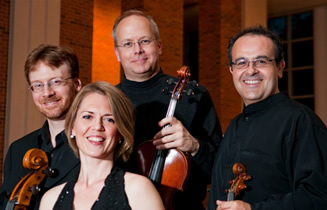Some of the concert programs in the Raleigh Chamber Music Guild’s Sights & Sounds on Sundays have to be shoe-horned to tie in with current exhibitions in the NC Museum of Arts. This concert featured the McIver String Quartet, faculty members of the UNC Greensboro School of Music, in an extraordinarily attractive program of two little-known French rarities and an apt Russian piece with strong ties to pre-WWI Paris. The selections were a fitting choice in conjunction with the museum’s extensive collection of sculptures by Auguste Rodin (1840-1917). The McIver players are violinists Marjorie Bagley and Fabián López, violist Scott Rawls, and cellist Alex Ezerman. Musicians gave informal program notes before each selection was played.
Born in Paris, composer Charles Koechlin (1867-1950) was a student of Gabriel Fauré. Maurice Ravel was a classmate. Koechlin’s broad range of interests included J. S. Bach, Kipling’s The Jungle Book, and Hollywood stars. His eclectic style drew inspiration from nature, oriental music, French folksong, and Bach chorales. His version of Impressionism is very distinct from both the better known Debussy and Ravel. The McIver chose Quartet No. 1 in D which is in three very attractive movements. Cellist Ezerman described them briefly. The opening Allegro moderato is pastoral in mood. A droning figure suggests the sounds of a musette, a small country bagpipe, a popular image in French music as far back as François Couperin Le Grand. The Scherzo features pizzicatos but very much Koechlin’s own, no copy of Debussy or Ravel. Ezerman drew attention to the composer’s use of “hanging harmonics.” Rawls played the long viola melody in the Andante quasi Adagio gloriously. Ezerman drew attention to the pointillist scoring in both the final Allegro con molto and the earlier Scherzo. The McIver played with beautiful, warm tone and very precise intonation. Balance was excellent. Their palette of tonal color was ideal for this repertoire.
The McIver, like the Emerson Quartet, play with the violinists and violist standing and the cellist seated on a box for added resonance. Violinist Bagley led both the Koechlin and the short Trois Pièces pour Quator à Cordes (1914) by Igor Stravinsky. She briefly described the piece and placed it in context. Driving rhythms and other characteristics of his ballets Firebird, Petrushka, and The Rite of Spring can be heard in the work. “Dance” is a peasant dance and its style is suggestive of Petrushka, “Eccentric” was inspired by the clown Little Tick, while a Byzantine mood of liturgical chant haunts “Canticle.” The McIver players turned in a precisely articulated and vivid account.
Violinist Fabián López took the first violin position for Quartet No. 1 in E minor, Op. 112 by Camille Saint-Saëns (1865-1921) while Bagley gave the program notes. The composer waited until he was sixty-four to write his first quartet, which was dedicated to the great Belgian violin virtuoso Eugène Ysayë and his ensemble. James Harding, in his program note for the Miami String Quartet CD of both Saint-Saëns quartets, says the composer possessed “a Mozartian precocity and had every technical gift a musician could possibly have wanted.” The first violinist is rarely out of the spotlight over the course of the four movements and the part is very demanding. The Allegro opens with a muted first violin singing a nostalgic melody before “bustling along in complex figurations.” The cello’s theme “blooms and then fades away among some deft contrapuntal and part writing.” The Molto allegro quasi presto, is immediately winning with its syncopated theme accompanied by pizzicato. “The third movement, Molto adagio shows Saint-Saëns at his most charming and anxious to please with a wistful melody on the violin.” The concluding Allegro non troppo is “a sharp and nervous affair packed with varying rhythms and contrapuntal devices” and an abrupt, rushed conclusion. The McIver Quartet turned in a passionate and precise performance, making the best possible case for a fascinating but uneven work. López’s efforts bordered on the Herculean since the composer placed so many demands on the first violin, which he met superbly. This was one of the most interesting and rewarding concerts of the entire season.












